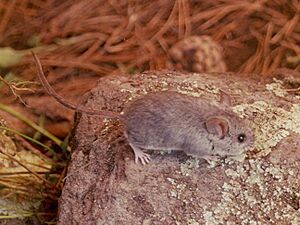Black-eared mouse facts for kids
Quick facts for kids Black-eared mouse |
|
|---|---|
 |
|
| In Chihuahua, Mexico | |
| Conservation status | |
| Scientific classification | |
| Genus: |
Peromyscus
|
| Species: |
melanotis
|
The black-eared mouse (Peromyscus melanotis) is a small rodent that lives in North America. It's also known as the black-eared deer mouse. These mice are part of the Cricetidae family, which includes many types of mice and hamsters.
About the Black-Eared Mouse
The black-eared mouse is one of the smaller mice in its group, called Peromyscus. It measures about 14 to 18 centimeters (5.5 to 7 inches) long from its nose to the tip of its tail. Its tail is fairly short, about 5 to 7 centimeters (2 to 2.8 inches) long.
Its fur is usually yellowish-brown. It's darker on its back and lighter on its sides. Its belly and feet are pure white. There's a clear line where the brown fur meets the white fur. It has a thin ring of dark fur around its eyes. Its ears are dark brown or black, but they have white edges. The tail is also furry and matches the body color, being brown on top and white underneath. In winter, their fur might look a bit lighter than in summer.
This mouse looks very much like a close relative, Peromyscus sonoriensis (also known as the Eastern deer mouse). It's hard to tell them apart just by looking at them. Even small differences in their fur or skull shape aren't always enough. Scientists often need to use special genetic tests to know for sure which mouse is which. These two types of mice cannot have babies together.
Where They Live and Their Home
Black-eared mice live in coniferous forests and mixed grasslands. You can find them in the central mountains of Mexico. Their home range stretches from the Trans-Mexican Volcanic Belt through the Sierra Madre Oriental and Sierra Madre Occidental mountain ranges. They also cross the border into the mountains of southern Arizona in the United States.
Within these areas, they might live in rocky places, marshy spots, or among the plants under trees. They prefer higher elevations, usually between 2,600 and 2,900 meters (8,500 and 9,500 feet) high. The P. sonoriensis mouse, which looks similar, tends to live on lower slopes in the same region. However, sometimes they can be found in the same ravines or at the edges of forests.
Mouse Habits and Life
Black-eared mice are nocturnal, which means they are active at night. They are also omnivorous, meaning they eat both plants and animals. Their main foods are seeds and insects.
Interestingly, these mice can eat monarch butterflies. Monarch butterflies have special bitter chemicals called cardenolides that most animals can't handle. But black-eared mice can eat quite a lot of them without getting sick!
During the day, these mice rest in their burrows. A burrow is like an underground home. Their nest chamber, where they sleep, is about 7 centimeters (2.8 inches) wide. It's connected to the surface by a vertical tunnel that goes down about 60 centimeters (2 feet). They are known to protect the area around their nests from other animals. For example, they might chase away Mexican volcano mice if they live in the same area.
Black-eared mice can have babies all year long. A mother mouse usually gives birth to three or four young at a time, but sometimes they can have up to five.



